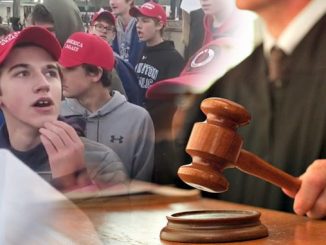
Hardware stores, airlines, government agencies are all using “facial recognition” technology to collect and store our biometric data–illegally.
By Dave Gahary
In the 2002 film “Minority Report,” Tom Cruise plays a police detective in Washington, D.C. in the year 2054, utilizing a prototype technology that prevents murders by employing three mutated humans—called “precogs”—who “previsualize” crimes by receiving visions of the future. Would-be murderers are incarcerated before they can kill, which has reduced the murder rate to zero.
The only problem is the system is faulty: The three precogs don’t always agree. The federal government hides this fact in order to roll out the program nationwide, and the bad guys set up Cruise, who’s uncovered the flaw in the system, forcing him to find a black-market doctor to conduct an eye transplant to trick the citywide optical recognition system. The optical recognition system employs retinal and iris scans to identify every person who passes by one of the devices, and also matches the unique eyeball signature to advertisers, who pitch their products as one makes their way around the city. Nothing to worry about, right? It’s science fiction, right? Wrong.
In September, four Illinois residents who have frequented Lowe’s and Home Depot stores in the Prairie State simultaneously filed virtually identical class action complaints against Lowe’s in Chicago and against Home Depot in Atlanta (where it is headquartered) in federal court, accusing the home-improvement retailers of violating the Illinois Biometric Information Privacy Act (BIPA) by “surreptitiously scanning customers’ faces” with their anti-theft surveillance systems.
BIPA is a 2008 law that protects against the collection and storing of biometric data unless customers are made aware of the electronic snooping. Illinois was the first state to regulate the collection of biometric data. Texas and Washington followed, but Illinois’s law is the only one that allows individuals to file suit for damages: $1,000 per violation, and $5,000 per violation if the violation is intentional or reckless. Legislatures in Alaska, Michigan, Montana, and New Hampshire have all tried—unsuccessfully in 2016 and 2017—to pass similar laws.
Retinal scans use the unique patterns of blood vessels to positively identify someone. Due to the sophisticated structure of the vessels that supply the retina with blood, each retina is unique, and although “retinal patterns may be altered in cases of diabetes, glaucoma or retinal degenerative disorders, the retina typically remains unchanged from birth until death.” Because of this, besides DNA, the retina is the most precise and reliable biometric measure, with a retinal scanning error rate of 1 in 10 million.
The lawsuit claims that Lowe’s and Home Depot “have augmented in-store security cameras with software that track individuals’ movements throughout the store using a unique scan of face geometry” and “surreptitiously attempt to collect the faceprint of every person who appears in front of one of their facial-recognition cameras,” using these anti-theft surveillance systems to “track shoppers across multiple stores and identify ‘suspicious’ shopping activity.” It also claims that the retailers “have shared the facial scan information of its customers with others.”
Just two weeks before news of this lawsuit broke, it was revealed that Delta Air Lines will start using facial recognition technology at one boarding gate at Los Angeles International Airport (LAX), which will allow passengers to confirm their identity with the cameras. Delta—with plans to permanently install the technology at “13 of its 21 boarding gates”—is known in the airline industry for using cutting-edge technology and “announced plans in June to install facial recognition cameras at 49 boarding gates at Hartsfield-Jackson Atlanta International Airport, Minneapolis−St. Paul International Airport and Salt Lake City International Airport.”
LAX has been used as a testing ground over the past year “for facial recognition technology by various airlines and federal agencies”—at three boarding gates at Tom Bradley International Terminal—including the Transportation Security Administration and U.S. Customs and Border Protection (CPB). The technology matches departing travelers’ faces with images and names in CPB’s and other government agencies’ databases.
American Airlines is currently testing its facial recognition technology at LAX as well, and has revealed it is adopting “facial recognition cameras to confirm the identity of international travelers at three boarding gates at Dallas Fort Worth International Airport.”
The technology is not without troubles, however. The Department of Homeland Security’s Office of Inspector General released an audit last year that found “pilot programs to test the technology at nine airports had a combined match rate of only 85%—below the agency’s goal of a 97% to 100% match rate.” The audit blamed poor digital image quality “for difficulty matching travelers under the age of 29 and over the age of 70,” as well as difficulties in “matching certain nationalities—specifically U.S. citizens, Mexicans, and Canadians—because the government’s ‘digital gallery’ had fewer photos of those nationalities than of other foreign travelers.”
Dave Gahary, a former submariner in the U.S. Navy, prevailed in a suit brought by the New York Stock Exchange in an attempt to silence him. Dave is the producer of an upcoming full-length feature film about the attack on the USS Liberty. See erasingtheliberty.com for more information and to get the new book on which the movie will be based, Erasing the Liberty.






